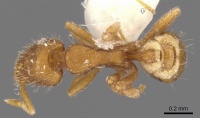Strumigenys emeswangi
| Strumigenys emeswangi | |
|---|---|

| |
| Scientific classification | |
| Kingdom: | Animalia |
| Phylum: | Arthropoda |
| Class: | Insecta |
| Order: | Hymenoptera |
| Family: | Formicidae |
| Subfamily: | Myrmicinae |
| Tribe: | Attini |
| Genus: | Strumigenys |
| Species: | S. emeswangi |
| Binomial name | |
| Strumigenys emeswangi (Bolton, 2000) | |
Nothing is known about the biology of Strumigenys emeswangi.
Identification
Bolton (2000) - A member of the Strumigenys rostrata-group. This small species is closely related to Strumigenys incerta. The two are separated as follows.
S. emeswangi: Hairs that project from side of occipital lobes include several pairs of longer fine to sub flagellate hairs, as well as shorter stouter hairs that are curved anteriorly. Anterior clypeal margin transverse to shallowly convex between points where outer margins of fully closed mandibles intersect the margin. Lateral spongiform lobe of petiole broad; in profile the maximum width of the lobe greater than the dorsal length of the node. Spongiform tissue of postpetiole relatively broad in dorsal view; maximum width of spongiform tissue on either side almost equal to the midline length of the disc. Larger, HL 0.56-0.57, HW 0.38-0.40, SL 0.28-0.30.
Strumigenys incerta: Hairs that project from side of occipital lobes all short, stout and curved anteriorly; no long fine to sub flagellate hairs present. Anterior clypeal margin concave between points where outer margins of fully closed mandibles intersect the margin. Lateral spongiform lobe of petiole narrow; in profile the maximum width of the lobe distinctly less than the dorsal length of the node. Spongiform tissue of postpetiole relatively narrow in dorsal view; maximum width of spongiform tissue on either side much less than the midline length of the disc. Smaller, HL 0.50-0.52, HW 0.33-0.34, SL 0.22-0.25. Tracking this small species through the key may lead to some confusion as numerous freely projecting hairs are present on the sides of the head. The point to note is that in emeswangi there is no apicoscrobal hair that is conspicuously different from hairs elsewhere on the dorsolateral margin.
The only other local species closely related to emeswangi is Strumigenys rostrataeformis of Japan, which may also eventually be found in China. The latter is easily differentiated as its specialised humeral hairs are stout and remiform, rather than being long fine and flagellate as in emeswangi.
Keys including this Species
Distribution
Distribution based on Regional Taxon Lists
Palaearctic Region: China (type locality).
Distribution based on AntMaps
Distribution based on AntWeb specimens
Check data from AntWeb
Countries Occupied
| Number of countries occupied by this species based on AntWiki Regional Taxon Lists. In general, fewer countries occupied indicates a narrower range, while more countries indicates a more widespread species. |

|
Estimated Abundance
| Relative abundance based on number of AntMaps records per species (this species within the purple bar). Fewer records (to the left) indicates a less abundant/encountered species while more records (to the right) indicates more abundant/encountered species. |

|
Biology
Castes
Nomenclature
The following information is derived from Barry Bolton's Online Catalogue of the Ants of the World.
- emeswangi. Pyramica emeswangi Bolton, 2000: 458 (w.) CHINA. Combination in Strumigenys: Baroni Urbani & De Andrade, 2007: 119
Unless otherwise noted the text for the remainder of this section is reported from the publication that includes the original description.
Description
Worker
Holotype. TL 1.8, HL 0.51, HW 0.34, CI 67, ML 0.05, MI 10, SL 0.24, SI 71, PW 0.22, AL 0.51. Basal dental row apparently of 5 acute teeth. Anterior clypeal margin broadly shallowly convex, approximately transverse immediately behind the dentate part of the fully closed mandibles. Anteriorly curved spatulate hairs that fringe the clypeus elongate, narrow and very prominent. Dorsolateral margin of head in full-face view with a variety of laterally projecting hairs. Those on anterior portion of upper scrobe margin relatively short, narrowly spatulate and curved anterodorsally, in length about equal to those fringing the lateral clypeal margins. Behind this with a few similar hairs but also with a number of longer, more shallowly curved and strongly prominent simple hairs, and with a few even longer finer subflagellate hairs. Leading edge of scape sharply angulate at subbasal bend, distinctly broadest at this point. With head in profile the ground pilosity of the dorsum behind the clypeus markedly elevated, mostly suberect. Pronotal humeral hair flagellate, very long and fine (abraded in holotype). Entire head, all of dorsal alitrunk and side of pronotum reticulate-punctate; mesopleuron and metapleuron unsculptured. Hairs on dorsal alitrunk fine and simple.
Paratypes. TL 1.8-2.0, HL 0.50-0.52, HW 0.33-0.34, CI 65-67, ML 0.04-0.05, MI 8-11, SL 0.22-0.25, SI 69-73, PW 0.21-0.24, AL 0.50-0.53 (4 measured).
Type Material
Holotype worker, China: Fujian Prov., Jiangle Co., Longqi Mt, 8.ix.1992 (Min-sheng Wang) (Museum of Comparative Zoology).
Paratypes. 4 workers with same data as holotype (MCZ, The Natural History Museum).
References
- Baroni Urbani, C. & De Andrade, M.L. 2007. The ant tribe Dacetini: limits and constituent genera, with descriptions of new species. Annali del Museo Civico di Storia Naturale “G. Doria” 99:1-191.
- Bolton, B. 2000. The ant tribe Dacetini. Memoirs of the American Entomological Institute. 65:1-1028. (page 458, worker described)
- Tang, K. L., Guénard, B. 2023. Further additions to the knowledge of Strumigenys (Formicidae: Myrmicinae) within South East Asia, with the descriptions of 20 new species. European Journal of Taxonomy 907, 1–144 (doi:10.5852/ejt.2023.907.2327).

